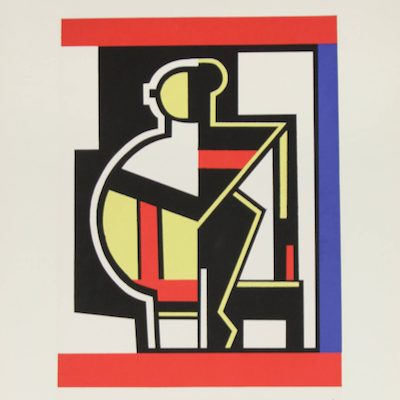
Details
Artist
Styles
Etching and aquatint in colours, on BFK Rives paper, with full margins. - This work is from the UNITÉ book, which began to be printed in 1963 and ended on October 15, 1965 in Paris. - I. 41.5 x 31.5 cm (16 3/8 x 12 3/8 in.) - S. 57 x 45.2 cm (22 1/2 x 17 3/4 in.) - Plate Signed and numbered in pencil - Published by Atelier Crommelynck, Paris // Le Corbusier’s Unité 12 (1963-1965) is a limited-edition etching and aquatint, printed on BFK Rives paper. The artwork is rendered in black and white, depicting an abstract scene with stylized figures and animals. The central form, a large figure with exaggerated shapes, dominates the composition, while to its left, a simplistic bird-like figure adds an element of surrealism. The minimalistic lines and geometric shapes are characteristic of Le Corbusier's abstract approach, suggesting themes of nature and humanity coexisting within structured forms. The repetitive, flowing lines evoke a sense of movement and balance, enhanced by the overall simplicity of the design.
Unité 12, 1963-1965
form
Medium
Size
57 x 45.2 cm
- Inches
- Centimeters
Edition
Price
- USD
- EUR
- GBP
Details
Artist
Styles
Etching and aquatint in colours, on BFK Rives paper, with full margins. - This work is from the UNITÉ book, which began to be printed in 1963 and ended on October 15, 1965 in Paris. - I. 41.5 x 31.5 cm (16 3/8 x 12 3/8 in.) - S. 57 x 45.2 cm (22 1/2 x 17 3/4 in.) - Plate Signed and numbered in pencil - Published by Atelier Crommelynck, Paris // Le Corbusier’s Unité 12 (1963-1965) is a limited-edition etching and aquatint, printed on BFK Rives paper. The artwork is rendered in black and white, depicting an abstract scene with stylized figures and animals. The central form, a large figure with exaggerated shapes, dominates the composition, while to its left, a simplistic bird-like figure adds an element of surrealism. The minimalistic lines and geometric shapes are characteristic of Le Corbusier's abstract approach, suggesting themes of nature and humanity coexisting within structured forms. The repetitive, flowing lines evoke a sense of movement and balance, enhanced by the overall simplicity of the design.
- Recently Added
- Price (low-high )
- Price (high-low )
- Year (low-high )
- Year (high-low )
What is Cubism?
Cubism is an art movement that aimed to depict multiple perspectives of objects or figures within a single picture. Artists Georges Braque and Pablo Picasso pioneered this style around 1907. The name Cubism emerged from their use of geometric shapes and outlines that often resembled cubes, breaking objects down into abstracted forms.






























